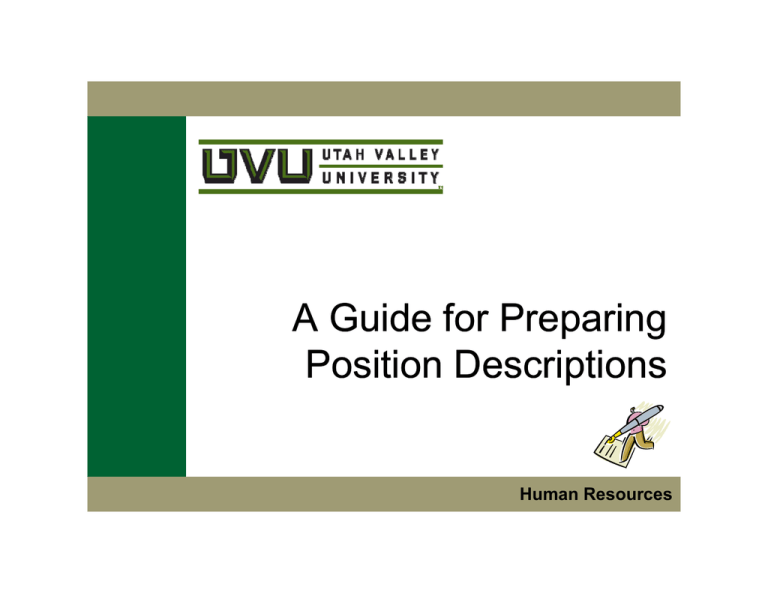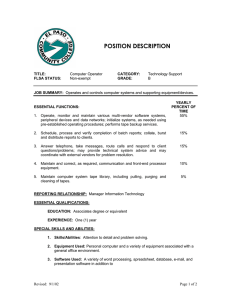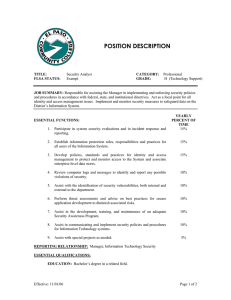A Guide For Preparing Job Descriptions
advertisement

A Guide for Preparing p g Position Descriptions Human Resources Key Session Outcomes Know why position descriptions are needed Know what should be included in a position description Know why each section is important Discover valuable writing aids Human Resources Why is a position description needed? Provides a clear and concise outline of the position’s key accountabilities, knowledge, skills, abilities and minimum qualifications. Serves as a tool to understand how the position fits within the department and the university. Assists in assigning value to the position. Helps to define the right type of person needed to fill the position. Provides a guide in evaluating employee performance performance. Provides information for consideration under the American’s with Disabilities Act (ADA). Human Resources When do you write a new position description? When a new position has been created and approved whose essential functions and minimum requirements do not compare to any existing position description within the university. – Example: E l E Essential ti l ffunctions ti and d minimum i i requirements i t ffor di director t positions iti are different. A position description is required for a new director position. When a position has changed substantially due to an organizational i ti l structure t t change. h Human Resources Do all new positions require a new position description? No. If the essential functions and minimum requirements compare to existing position descriptions within the University a new position description is not needed. needed – Example: Essential functions and minimum requirements for academic advisor positions are the same. A new position description is not necessary. Job descriptions can be modified as business needs arise arise. Human Resources What should be included in a position description? Position Title Department Reporting Relationship Position Summary Essential Functions Special Requirements of the position Supervisory Responsibilities Minimum Qualifications Knowledge, Skills, Abilities Human Resources Position Title, Department, Reporting p g Relationship, p, Position Summary Position Title – Title is assigned in collaboration with HR and Job Slotting Committee Department – Name of department where the position resides resides. Reporting Relationship – Title of position that the new position will report to. Position Summary – Summarize the position and describe the role the position fills in the area. The summary should be no more than two or three sentences. Human Resources Essential Functions Major duties and/or key accountabilities. – List the recurring accountabilities and duties that define the position position. – Not a detailed listing of tasks. Section is critical when determining if an accommodation d ti iis possible ibl under d th the A American i with ith Disabilities Act (ADA).* e es what at a an e employee p oyee must ust do with t o or without t out Defines reasonable accommodation. *For further information regarding ADA and how it applies to the UVU workplace, contact the ADA Coordinator at ext. 8643. Human Resources Essential Functions Reasons why a function could be considered essential: – – There are a limited number of other employees available to perform g whom the function can be distributed. the function,, or among – The position exists to perform the function. Example: If you hire someone to proofread documents, the ability to proofread accurately is an essential function, since this is the reason that the position exists. exists. Example: It may be an essential function for a file clerk to answer the telephone if there are only three employees in a very busy office, and each employee has to perform many different tasks. A function u ct o is s highly g y specialized, spec a ed, and a d tthe e pe person so in tthe e pos position t o is s hired for special expertise or ability to perform it. – Example: A company expanding its business with Japan is hiring a new salesperson, so requires someone not only with sales experience, but also with the ability to communicate fluently y in the Japanese p language). g g ) Human Resources Essential Functions Answers the following questions: – What duties does the employee perform on a daily basis? – What critical outcomes or results is the employee accountable for? – What percent of time is spent on the essential function? Each essential function on the list should comprise at least 10% of the incumbent’s incumbent s time (4 hrs/week). Human Resources Essential Functions Prioritize according g to the p percent of time spent p on the function. Duties and responsibilities no longer performed or th those that th t may be b required i d in i th the ffuture t should h ld nott b be included. Begin each essential function with an action verb. Human Resources Supervisory Responsibilities - List anyy direct reports p for which the p position has hiring, g, firing, promoting, and performance responsibilities. – Include direct report’s title, job grade, Fair Labor Standards Act (FLSA)* status (exempt or nonexempt), and whether they are a fullfull-time, part part--time or student employee. *Fair Labor Standards Act (FLSA): a federal law which establishes minimum wage, overtime pay, recordkeeping and youth employment standards affecting full-time and part-time workers in the private sector and in Federal, State, and local governments Human Resources Special Requirements of the Position List any physical and/or working conditions required. – Should be based on the minimum physical requirement for performing the position. – Be careful when listing special requirements of the position. Does the position require the employee to lift 50 pounds, or does it require the ability to move a box of paper from one location to another? (could use dolly or move one ream at a time) Does the position require the employee to walk across campus or move across campus? (for security positions the ability to walk or run would be essential) – Every entry in this section must be directly supported in the “Essential Functions” section. Human Resources Qualifications List the education and experience p needed to satisfactorily perform a position. – Must be based on the minimum requirements for performing the position. – What is really needed? Is there tolerance for a new person’s learning curve or, do you need to hire someone with specific experience? Human Resources Knowledge, Skills & Abilities Q Qualifications a person p must p possess to satisfactorily y perform the essential functions of a position. Entries in this section must be supported by the “E “Essential ti l F Functions” ti ” section. ti Knowledge, Skills & Abilities are used to score position applications and interviews. Human Resources Knowledge, Skills & Abilities Knowledge – Defines the mental aspects of position. What employee must know (usually obtained through education, training or experience ) experience.) Example: accounting principles Skills – Defines the manual and/or applied mental aspects of the position. What employee must be able to do (typically obtained through experience or training) Example: maintain general ledger Abilities – Typically defines aptitudes present at birth birth, but may in some cases be acquired. Natural talents or developed proficiencies p balance multiple p p priorities Example: Human Resources Tips Be precise. Begin each sentence with an action verb verb. Keep sentence structure as simple as possible. Omit unnecessaryy words that do not contribute pertinent information. Describe current duties as they exist now, not as they may be performed in the future future. Human Resources Tips Define acronyms to assist in the review, evaluation, and clarification of the position position. Focus on critical activities. – Disregard minor occasional tasks which are not unique to a specific position. iti Be specific on skills requirements – Use “Ability to clearly present technical concepts to a nonnon-technical audience” or, “Ability to communicate technical information to nonnontechnical audiences” rather than “Strong communication skills”. Human Resources Tips For clarity, use explanatory phrases that tell how, why, where, or how often. – Instead of “distributes distributes questionnaires” questionnaires , use “distributes distributes all questionnaires to develop a comprehensive database of feedback from customers.” A position description is a legal document. – Typically, yp y any y reference to race, color, religion, g sex, national origin, g age, g disability y or veteran status is illegal. The position must be truly doable. – When combining several tasks into the same position description, ensure that you are not creating ti a position iti few f people l could ld accomplish. li h Make sure that the Knowledge, Skills and Abilities support the Essential Functions. Human Resources Example - Custodian Clean bathroom sinks, toilets, mirrors, floors and spot wash the walls. Removes trash and soiled waste from the women’s bathroom. Maintain rooms so they are available for prompt reuse by cleaning ledges, fixtures, washing walls, vents and lights. Complete required continuous training and educations, including department depa t e t spec specific c requirement. equ e e t Thoroughly cleans and maintains all bathrooms for prompt use. Human Resources Remember HR is available to offer guidance in writing your position description. Compensation Specialist – Ext. 6089 Human Resources



